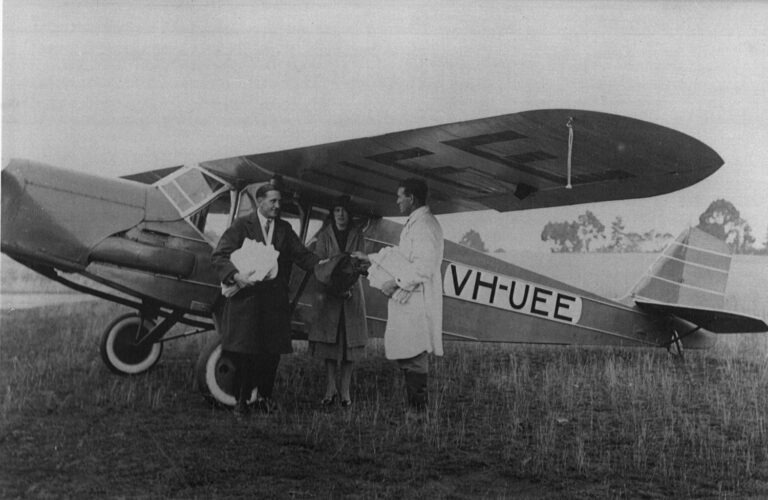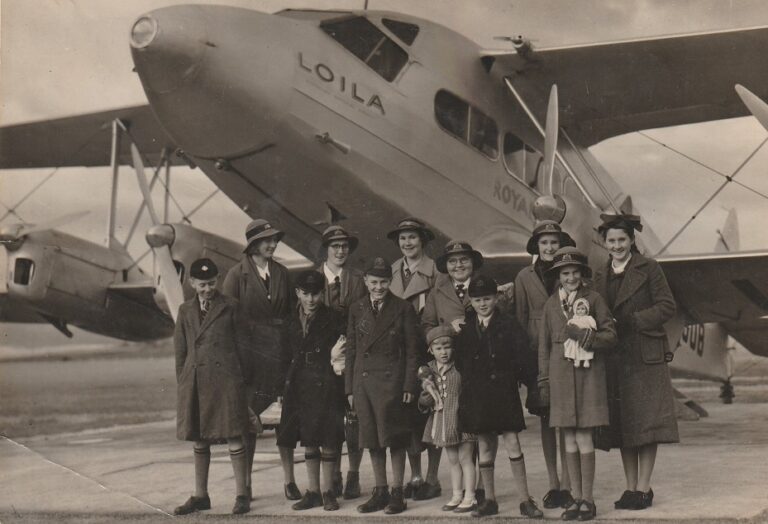Prior to the advent of aviation, Bass Strait Islanders relied upon shipping services which visited once or twice a month. Newspapers would have ‘old’ news when they were delivered. Aviation provided a regular airmail service, allowing newspapers to be delivered the same day they were printed.

1931 – 1933
Airmail Services Across Bass Strait
The first airmail service from the mainland to Tasmania was flown by Kingsford Smith’s A.N.A. between May and June 1931. Flinders Island received its first airmail in 1932 and King Island in 1933.
Commercial aviation did not attract any Government subsidies, (unlike the railways that did). Carrying airmail was the only revenue source early aviators had besides passenger fares.
In the 1930s, a standard letter postage was 2d, (about 83c today). An additional surcharge of 3d, ($1.25 today), was then added to air mail letters. The Postmaster General would issue air mail contracts on specific routes to specific operators. The planes could then carry the “Royal Mail” warrant on their fuselage.
The first airmail service in Tasmania was on the Melbourne to Launceston and Hobart service by Kingsford Smith’s A.N.A. It operated for two months in May and June 1931. It stopped when ANA ceased operation.
The next airmail service was from Tasmania to Flinders Island by Lawrence Johnson. He piloted Miss Flinders carrying airmail for the first time on 07 June 1932. There were 412 airmail letters to the island and 73 letters back to Tasmania. Flinders Island now had three airmail flights a week, and one regular mail service by ship every two weeks.
In 1933 when passenger services resumed between Melbourne and Tasmania, all three operators carried airmail on different days. King Island received airmail letters from October 1933 when the inter-state planes visited.
1932
Medical Evacuations
Passenger services to Flinders and King also undertook urgent medical evacuations. Lawrence Johnson, piloting Miss Flinders, carried out the first medical evacuations from both Flinders and King Islands.
With the start of passenger services to both Flinders and King Islands with Miss Flinders and Miss Currie, these planes were called upon to undertake urgent medical evacuations from the islands.
Lawrence Johnson had flown Miss Flinders on its first passenger flight to Flinders Island on 19 March 1932. The following evening, he received an urgent telegram from Dr. Connell, of Flinders Island, that his patient, Mr. Alfred Cook was in urgent need of an operation in Launceston.
At daybreak the following morning, Miss Flinders left Western Junction and flew through heavy rain with bad visibility to Whitemark. Mr. Cook was then placed on the floor of the plane for the return flight. The Launceston city ambulance was waiting on the landing strip and rushed Mr. Cook to the Launceston Public Hospital for the operation.
The first aero medical evacuation from King Island was undertaken on 27 February 1933, two months after Tasmanian Aerial Services commenced its service to the island. A man required an emergency operation in Melbourne. Lawrence Johnson again was the pilot of Miss Flinders, which departed Western Junction at daybreak. After picking up the man at King Island, they then flew to Essendon.
Miss Currie would later be used as an air ambulance when the Australian Aerial Medical Service (the forerunner to Royal Flying Doctor Service) was established at Broken Hill in 1937.

1932
Air Freight
New Shopping opportunities provided to Islanders through Lawrence Johnson’s and Miss Flinders air freight service!
Johnson never returned from Flinders Island without a list of personal shopping commissions from the Islanders. He would make these purchases in person, then fly the parcels back to the island on his next trip.
Most such merchandise he handled was orthodox enough, but once he carried a selection of diamond engagement rings, borrowed from a Launceston jeweller. A starry-eyed Islander was awaiting him on the Flinders Island airfield, and while Johnson was unloading his passengers and freight, the Islander studied the rings and made a choice.
“I’ll have this one,” he said, handing back the balance of the rings and, with them, a cheque for the jeweller. The engagement ring was earmarked for the finger of an attractive young schoolteacher Johnson had flown to the island in the Desoutter a few trips earlier.
An excerpt from He Helped to Found a Major Airline by John Hetherington, Aircraft, February 1952

1932
School Children Returning Home
One of the passengers on the first flight to King Island was a schoolgirl returning home.
As reported by the Launceston Examiner on 29 December 1932:
King Island has been brought infinitely closer to the mainland as the result of the inauguration of the air service by Tasmanian Aerial Services Pty. Ltd.
Before the advent of the air service the island had a weekly steamer from Melbourne (if the weather was good enough to allow the vessel to get into the port) and a fortnightly service from Launceston (also if the weather was good).
But now all this is changed. Instead of receiving a newspaper at the best once a week, the islanders now receive copies of “The Examiner” twice a week.
The air service was inaugurated on Saturday last (Christmas Eve). when Captain V. C. Holyman flew the company’s Fox Moth “Miss Currie” to the island, via Latrobe, Wynyard, and Smithton. There were two passengers to the island, Mr. Waterworth from Wynyard, and Miss K. Jackson from Launceston. The passengers were landed on the island just before midday.
Miss Jackson, who is a pupil of the Launceston State High School, was returning to King Island for the school vacation. On previous occasions Miss Jackson had been unable to get to the island for her holidays, but apparently the aeroplane has changed this too. It will be remembered that Miss Jackson was In the wreck of the Collibol while going to the island for her previous holiday. On other occasions she has been overcarried by the steamer Marrawah, and was on board the Tambar when she went aground on the Tasmanian coast.
